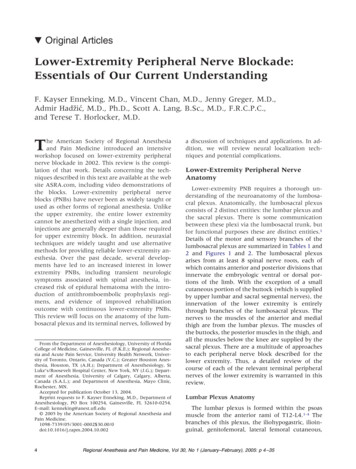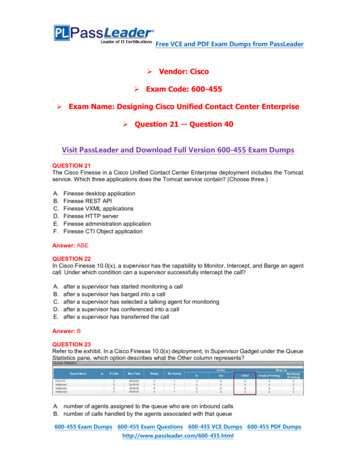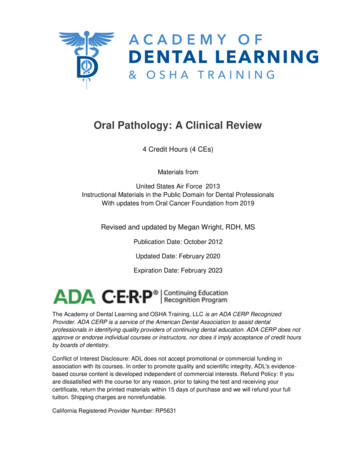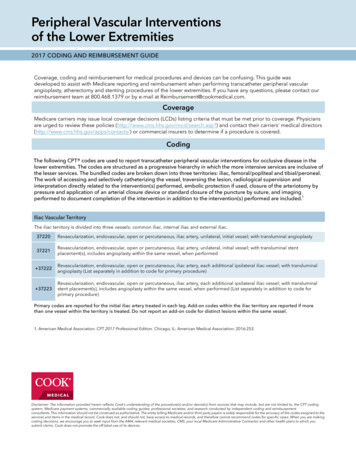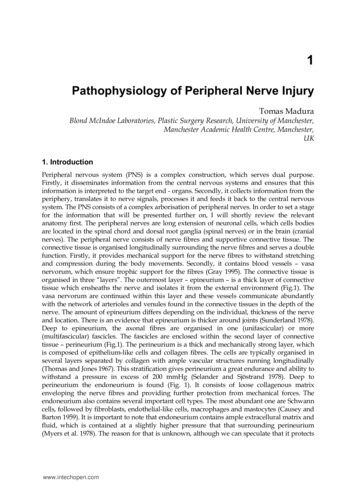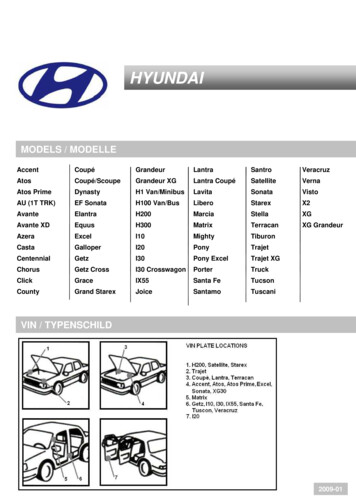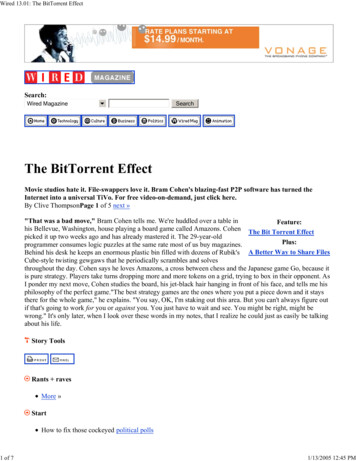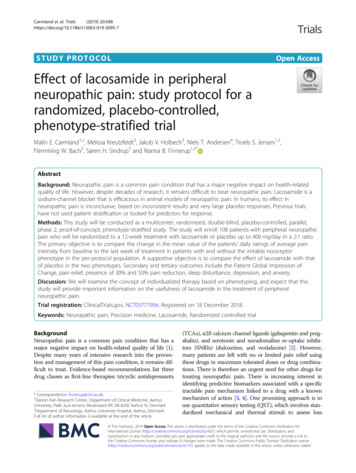
Transcription
Carmland et al. Trials(2019) DY PROTOCOLOpen AccessEffect of lacosamide in peripheralneuropathic pain: study protocol for arandomized, placebo-controlled,phenotype-stratified trialMalin E. Carmland1,2, Melissa Kreutzfeldt3, Jakob V. Holbech3, Niels T. Andersen4, Troels S. Jensen1,2,Flemming W. Bach2, Søren H. Sindrup3 and Nanna B. Finnerup1,2*AbstractBackground: Neuropathic pain is a common pain condition that has a major negative impact on health-relatedquality of life. However, despite decades of research, it remains difficult to treat neuropathic pain. Lacosamide is asodium-channel blocker that is efficacious in animal models of neuropathic pain. In humans, its effect inneuropathic pain is inconclusive, based on inconsistent results and very large placebo responses. Previous trialshave not used patient stratification or looked for predictors for response.Methods: This study will be conducted as a multicenter, randomized, double-blind, placebo-controlled, parallel,phase 2, proof-of-concept, phenotype-stratified study. The study will enroll 108 patients with peripheral neuropathicpain who will be randomized to a 12-week treatment with lacosamide or placebo up to 400 mg/day in a 2:1 ratio.The primary objective is to compare the change in the mean value of the patients’ daily ratings of average painintensity from baseline to the last week of treatment in patients with and without the irritable nociceptorphenotype in the per-protocol population. A supportive objective is to compare the effect of lacosamide with thatof placebo in the two phenotypes. Secondary and tertiary outcomes include the Patient Global Impression ofChange, pain relief, presence of 30% and 50% pain reduction, sleep disturbance, depression, and anxiety.Discussion: We will examine the concept of individualized therapy based on phenotyping, and expect that thisstudy will provide important information on the usefulness of lacosamide in the treatment of peripheralneuropathic pain.Trial registration: ClinicalTrials.gov, NCT03777956. Registered on 18 December 2018.Keywords: Neuropathic pain, Precision medicine, Lacosamide, Randomized controlled trialBackgroundNeuropathic pain is a common pain condition that has amajor negative impact on health-related quality of life [1].Despite many years of intensive research into the prevention and management of this pain condition, it remains difficult to treat. Evidence-based recommendations list threedrug classes as first-line therapies: tricyclic antidepressants* Correspondence: finnerup@clin.au.dk1Danish Pain Research Center, Department of Clinical Medicine, AarhusUniversity, Palle Juul-Jensens Boulevaard 99, DK-8200 Aarhus N, Denmark2Department of Neurology, Aarhus University Hospital, Aarhus, DenmarkFull list of author information is available at the end of the article(TCAs), α2δ calcium channel ligands (gabapentin and pregabalin), and serotonin and noradrenaline re-uptake inhibitors (SNRIs) (duloxetine, and venlafaxine) [2]. However,many patients are left with no or limited pain relief usingthese drugs in maximum tolerated doses or drug combinations. There is therefore an urgent need for other drugs fortreating neuropathic pain. There is increasing interest inidentifying predictive biomarkers associated with a specifictractable pain mechanism linked to a drug with a knownmechanism of action [3, 4]. One promising approach is touse quantitative sensory testing (QST), which involves standardized mechanical and thermal stimuli to assess loss The Author(s). 2019 Open Access This article is distributed under the terms of the Creative Commons Attribution 4.0International License (http://creativecommons.org/licenses/by/4.0/), which permits unrestricted use, distribution, andreproduction in any medium, provided you give appropriate credit to the original author(s) and the source, provide a link tothe Creative Commons license, and indicate if changes were made. The Creative Commons Public Domain Dedication o/1.0/) applies to the data made available in this article, unless otherwise stated.
Carmland et al. Trials(2019) 20:588(negative signs) and gain (positive signs) of sensory function. In a phenotype-stratified randomized, double-blind,placebo-controlled study, our research group has recentlyshown that the sodium channel blocker oxcarbazepine reduced pain more in patients with the so-called irritablenociceptor phenotype than in patients without this phenotype [5]. In addition, a malfunctioning descending painmodulation (e.g. assessed by the conditioned pain modulation (CPM) test) [6] and patient-reported outcomesassessed with validated questionnaires such as the Neuropathic Pain Symptom Inventory (NPSI) may represent predictive biomarkers for drug efficacy [7].Lacosamide is a functionalized amino acid molecule, developed as an antiepileptic drug. It selectively enhancesthe slow inactivation of voltage-gated sodium channelsand interacts with the collapsin-response mediatorprotein-2 (CRMP-2), which is involved in neurotrophicpathways [8]. Lacosamide is efficacious in animal modelsof neuropathic pain [9]. In humans, the effect of lacosamide on neuropathic pain is inconclusive, based on inconsistent results and very large placebo responses (i.e. a largereduction in pain intensity during placebo treatment) inthe few randomized controlled trials (RCTs) [2, 10–13].Improvements were seen for secondary variables such assleep, patient global impression of change (PGIC), qualityof life, and pain interference; and two trials with multipledosing showed efficacy of lacosamide 400 mg on the primary outcome [11, 12]. Recently, a study in patients withSCNA9A-associated painful small-fiber polyneuropathyhas been carried out [14]. These studies did not reveal serious or clinically relevant safety issues, and the majority ofreported adverse events (most commonly dizziness, nausea, and headache) were mild to moderate. Previous lacosamide trials have not used patient stratification or lookedfor predictors. The aim of this study is therefore to assesswhether specific pain phenotypes based on sensory testingare linked to an increased response to lacosamide in patients with peripheral neuropathic pain.Standard Protocol Items: Recommendations for Interventional Trials (SPIRIT) were used in writing thismanuscript (see Fig. 1 and Additional file 1).Methods/designObjectiveThe primary objective is to compare the change in averageintensity of neuropathic pain from the baseline week tothe last week of lacosamide treatment in patients with andwithout the irritable nociceptor phenotype who completeat least 2 weeks on stable medication with at least 100 mgbid; that is, in the per-protocol (PP) population (Fig. 2).The supportive objective is to compare the effect oflacosamide with placebo in the two phenotype groups inthe PP population (Fig. 2). Although we do not expect aphenotype difference in the response to placebo, aPage 2 of 8comparison of the effect of lacosamide versus placebo isneeded to justify that the phenotype is a predictive biomarker for the effect of lacosamide.Exploratory objectives To analyze whether the change in pain intensityfrom baseline to the last week of lacosamide andplacebo treatment depends on preserved thermalsensation (QST), gain of sensation (QST), paincharacteristics as determined by the NPSI, or evokedpain ratings in the bedside sensory testing If there is no phenotype difference, we will comparethe primary and secondary outcomes in the totalpopulation To analyze whether there is a correlation betweenthe percentage change in pain score from thebaseline week to the last week of treatment and theeffect of conditioned pain modulation (CPM) [6] To analyze predictors of the placebo response(CPM, patient expectation, age, gender, anxiety anddepression scores at first examination, pain duration,baseline pain variability, and adverse events)Study design/planThe study will be conducted as a multicenter, randomized,double-blind, placebo-controlled, parallel, phase 2, proofof-concept study, a collaboration between the Departmentof Neurology, Odense University Hospital, the DanishPain Research Center, Aarhus University, and the Department of Neurology, Aarhus University Hospital. The studycomprises a 1-week baseline period and a 12-week treatment period followed by a 3-week period including a tapering down and follow-up period (Fig. 3). Patients shouldhave an average intensity of pain of at least 4 (NRS scale)and not above 9 in the baseline period, but this is not revealed to the patient. Before inclusion, the diagnosis ofprobable or confirmed neuropathic pain will be confirmedby the investigator using a detailed pain history, focusedclinical and neurological examination, and evaluation ofprevious paraclinical examinations.At screening, QST will be performed according to thestandard practice and a standard protocol [15]. QST willbe used to categorize patients as having either the irritable or the non-irritable nociceptor phenotype [5]. QSTwill be done by a nurse not otherwise involved in thestudy, and the investigators and study nurses involved inthe study will be blinded to the results of the QST andthe phenotype of the patients. The patients are not informed about their pain phenotype and its expected impact on pain relief, and thus the exact definition ofirritable nociceptor phenotype is provided only in thestudy protocol submitted to the ethical committee. Trial
Carmland et al. Trials(2019) 20:588Page 3 of 8Fig. 1 Standard Protocol Items: Recommendations for Interventional Trials (SPIRIT) figure. Schedule of enrolment, interventions, and assessment.1The 3-week follow-up includes a 1-week tapering down and a 2-week follow-up with no medication. Telephone call after the 3-week follow-up.In the case of unresolved side effects at this call, an additional call is scheduled after 1–4 weeks. 2Patients treated with pregabalin will come foran extra visit. ECG electrocardiogram, PGIC Patient Global Impression of Changeparticipants and all personnel involved in the study areblinded to assignment to interventions.At the screening, patients will be trained in reportingpain intensity accurately, using cases to improve the patients’ understanding of the numeric rating scale (NRS)and how to score their average daily pain.Study drugsThe trial medication will be supplied from the pharmacyat Odense University Hospital (Sygehus Apotek Fyn).Lacosamide (50 mg) and identical placebo are given ascapsules and taken orally twice a day. We have adapteda slow titration in an attempt to increase tolerability andreduce dropout. Patient will start with 50 mg bidfollowed by a 6-week titration phase, increasing the doseby 50 mg weekly to 150 mg bid in week 5 with an increase to 200 mg bid in week 6. The maximal dose is400 mg/day (200 mg bid), and the dose is kept constantfrom week 6 until the end of the treatment period. If patients experience intolerable side effects, they are
Carmland et al. Trials(2019) 20:588Page 4 of 8Fig. 2 Primary and supportive objectives. IN irritable nociceptor, NIN non-irritable nociceptor, R randomizationpermitted to lower the dose to the highest tolerabledose, but not lower than 100 mg bid. After the treatment, the patients will have a 1-week tapering-downperiod, following which they will continue in the studyfor another 2 weeks. This is done to assess whether thepain returns to baseline values, which is relevant inorder to understand possible placebo responses. Theallowed escape medicine for any type of pain during allof the study periods is paracetamol, up to 4000 mg daily,and the intake is noted in a diary.and via advertisements. Patients with peripheral neuropathic pain following peripheral nerve injury (including amputation), painful polyneuropathy, postherpetic neuralgia,and painful radiculopathy will be included. Patients withcentral neuropathic pain (e.g. pain due to stroke, multiplesclerosis, and spinal cord injury) will not be included. Patients with trigeminal neuralgia, which is sometimes partlya central neuropathic pain and has different treatment recommendations, will also not be included. Patients withCRPS type I or II will not be included.Study populationInclusion criteriaPatients with peripheral neuropathic pain will be recruitedfrom the Department of Neurology, Odense UniversityHospital, the Pain and Headache Clinic, Department ofNeurology, Aarhus University Hospital, other departments,1. Age 18 years2. Verified probable or definite peripheral neuropathicpain for at least 3 months [16]Fig. 3 Study design. Blue arrows, visits; red arrows, telephone calls. IN irritable nociceptor, NIN non-irritable nociceptor, QST quantitative sensorytesting, R randomization, V visit
Carmland et al. Trials(2019) 20:5883. Average pain intensity of at least 4 and not above 9on an 11-point (0–10) NRS during the 7-day baseline week4. Written informed consent (Additional file 2)Exclusion criteria1. Other causes of pain in the same area or otherconcomitant pain that cannot be distinguished fromthe neuropathic pain2. Patients who cannot cooperate or are expected notto be able to complete the project and patients whodo not speak Danish3. Known and current cardiac conduction disturbance(2 or 3 atrioventricular (AV) block, prolongedQTc interval 450 ms, heart rate 50 or 110 bpm,QRS interval 120 ms (ECG required)), significantcardiac, renal, or liver disease, or other severeillness; sitting diastolic blood pressure below 50mmHg or above 105 mmHg; in patients treatedwith pregabalin, also PQ interval 0.2 s4. Major depressive episode within 6 months,recurrent depressive disorder or other significantpsychiatric disease, and alcohol, illicit drug ordrug abuse5. Pregnancy or lactation6. Woman of childbearing potential, unless they useacceptable effective contraception as defined in theClinical Trials Facilitation Group (CTFG) duringthe study and at least 2 weeks after, or if their malepartner has had a vasectomy and is their solepartner; a negative pregnancy test is required;acceptable effective contraception is defined in theCTFG (http://www.hma.eu/fileadmin/dateien/Human Medicines/01-About HMA/WorkingGroups/CTFG/2014 09 HMA CTFGContraception.pdf)7. Known allergy to lacosamide or excipients8. Concomitant pain treatment with tricyclicantidepressants, topical analgesics (lidocaine,capsaicin), lamotrigine, oxcarbazepine,cannabinoids, or strong opioids that cannot bediscontinued; other treatments for neuropathic painare allowed in a stable dose (from 14 days beforerandomization to completion of the trial) if theycannot be tapered off completely9. Concomitant treatment with products known to beassociated with PQ (PR) prolongation other thanpregabalin10. Patients inappropriate for placebo treatment11. Planned surgery12. Use of sodium channel blockers within at least fivehalf-lives and investigational drugs within 30 daysPage 5 of 813. Patients on a controlled sodium diet unless theamount of sodium in the capsules is acceptable fortheir diet14. The score “yes” on item 4 or item 5 of the SuicidalIdeation section of the Columbia Suicide SeverityRating Scale, if the ideation occurred in the past 6months, or “yes” on any item of the SuicidalBehavior section, except for the “Non-suicidal SelfInjurious Behavior” if this behavior occurred in thepast 2 yearsPain diaryPatients will keep a diary in which they will record theirdaily average pain score as assessed on the NRS (0–10)from the baseline week before treatment, throughout thetreatment period and for another 3 weeks. The diary willbe electronic (or, in some cases, on paper). The patientswill also record their daily intake of study medicationduring the treatment period and their use of escapemedication (number of tablets). The investigators will ona regular basis check that the diary is filled out duringthe treatment period, and daily during the first and lastweeks to avoid missing data.RandomizationRandomization to the two treatments is done after thebaseline period, by the pharmacy, using a computergenerated randomization list using block sizes unknownto the investigators. The patients will be stratified intotwo groups: patients with and without the irritable nociceptor phenotype. Allocation concealment will be ensured, as the randomization code will not be releaseduntil after the phenotype has been established and patients are randomized consecutively. The code forrandomization will be stored in the pharmacy until thestudy is completed. Both sites receive for eachrandomization code a sealed envelope with informationon the treatment given. The code envelope is only unsealed/opened in emergency cases if the safety of the patient requires knowledge of the randomization code.ComplianceIn the pain diary, patients are required to record theirintake of study medication morning and evening. Residual capsules shall be returned at the end of the treatment period (visit 3). The number is compared with thedaily records of consumption of capsules in the dairyand the number of returned capsules is also recorded onthe case report form. Furthermore, patients are contacted via telephone at least once during the treatmentperiod and interviewed in a standardized manner to ensure compliance.
Carmland et al. Trials(2019) 20:588OutcomesPrimary outcome The difference in the mean value of the patients’daily ratings of average pain intensity in the baselineweek and the last week during treatment asexperienced during the past 24 h rated on an 11point numeric rating scale (NRS; 0 no pain, 10 worst possible pain)Page 6 of 8the pain side); pain is rated on the NRS (0–10)(visits 2 and 3) Hyperpathia assessed by repetitive mechanicalpinprick stimulation at a rate of 2 Hz for 60 s andpain on the NRS (0–10) at 10-s intervals until theevoked pain has ceased [17] (visits 2 and 3) Nerve excitability testing is performed on the(nonaffected) wrist (visits 2 and 3)Other outcomesSecondary outcomes Pain relief (complete, good, moderate, mild, none,worse pain) (visit 3) Use (average numbers of tablets and number ofsubjects taking any dose) of escape medication(paracetamol) during the treatment periodTertiary outcomes The Patient Global Impression of Change (PCIG) measures the patients’ overall change (all aspects ofgeneral health) from baseline on a 7-point scale(very much improved, much improved, minimallyimproved, no change, minimally worse, much worse,very much worse) (visit 3)Pain impact on activities, sleep, and mood (NRS 0–10, from no impact to worst impact possible) (visit 2and 3)Mean values of the daily pain ratings for the other11 weeksPresence of 30% and 50% reduction of pain (frompain diary, baseline vs. last week of treatment)Symptoms of depression and anxiety and sleepdisturbance assessed using the Patient-ReportedOutcome Measurement Information System (PROMIS), the PROMIS questionnaire asks about symptoms experienced during the previous 7 days with afrequency or severity grading of symptoms; thescores are converted into PROMIS T scores, whichare standardized relative to an American/US reference population, and to categories of impairment(normal and mild, moderate, and severe impairment)[16] (visits 2 and 3)The intensity of pain symptoms assessed by theNeuropathic Pain Symptom Inventory (NPSI) [7](visits 2 and 3)Mechanical allodynia is assessed by brushing a softbrush (Somedic) twice with a speed of 1–2 cm/s andcold allodynia is assessed twice by a 20 C coldthermal roller (Somedic); pinprick hyperalgesia isassessed using a pinprick stimulator as the differencein pain score (two stimulations at a control and at Adverse events assessed by open-ended questions Suicidal ideation and behavior assessed using theColumbia Suicide Severity Rating Scale [18] Assessment of blinding of trial; at visit 3, theassessment from the patient and investigator isrecorded in the CRF, whether they think the patientreceived an active treatment or placebo, or do notknow, and on what reason this is based (side effect,effect on pain, or something else) (visits 2 and 3) Assessment of patients’ expectations for the studydrug (visit 1) A qualitative assessment of any difference inoutcome based on the pain intensity ratings in thepain diary, the PGIC, and pain relief scores (visit 3) Blood samples will be taken for a biobank, and in asubgroup of patients treated with lacosamide we willperform genetic analyses of voltage-gated sodiumchannels, β-subunit 1–4, and Collapsin ResponseMediated protein 2.Data management planCase report forms (CRFs) for each subject screened and enrolled in this study will be completed directly in the ResearchElectronic Data Capture (REDCap) database to the extentpossible without the use of a paper CRF. REDCap is hostedby Aarhus University. Source documents include medical records, pain diaries, and CRFs (paper or REDCap (eCRF)).The study personnel at each site will be trained in the studyprocedures. All investigators will have access to the final trialdata set. After the study, anonymized data will be available ina data repository and will be available upon request subjectto written agreement with a department head.StatisticsWith a minimally relevant between-phenotype groupdifference in total pain reduction of 1.25 NRS points, astandard deviation of 1.6 within phenotype groups [5],80% power, and a 5% risk of type I error, the sample sizeestimate is 27 27 patients for the primary objective.With a minimally relevant treatment versus placebo difference in total pain reduction of 1.5 NRS points, 80%power, and a 5% risk of type I error, the sample size estimate is 30 15 patients using a treatment:placebo ratio of
Carmland et al. Trials(2019) 20:5882:1 for the supportive objective. With an expected dropoutrate of 1/6 (data available for intention-to-treat (ITT) analysis), the recruitment stops when 54 patients in eachphenotype group have been randomized to lacosamideand placebo in a 2:1 ratio. Thus, we expect to randomize108 patients. For the explorative outcome in case there isno phenotype difference, 72 patients randomized to lacosamide and 36 patients randomized to placebo in the totalpopulation in an ITT population will give 90% power tofind a minimally relevant treatment versus placebo difference in total pain reduction of 1.25 NRS points and 85%power to find a minimally relevant treatment versus placebo difference in total pain reduction of 1.0 NRS points.Statistical analysis of the primary outcome will be performed by t test and of the secondary outcomes by theMann–Whitney U test. Nondichotomous tertiary outcomeswill be performed by t test or Mann–Whitney U test, whereapplicable. Since we do not expect differences in baselinebetween the two phenotypes [5], a major impact of baselinepain intensity on the outcome, or a center effect, we do notplan to include these as covariates in the analyses.For the primary outcome, the delta values from theaverage pain intensity in the baseline week to the lasttreatment week (last 7 days) will be used. Response ratesand other dichotomous data are analyzed using Fisher’sexact test. For the primary (and supportive) objective,we are interested in the mechanistic aspects and in understanding whether the sensory phenotype “irritablenociceptor” is a prognostic biomarker for a sodium channel blocker in therapeutic doses. Therefore, the primaryanalysis for the primary objective is the PP population.Missing data will not be replaced. The PP populationcomprises those patients who complete at least 2 weekson stable medication with at least 100 mg bid. Thus, if patients who fulfil the PP definition stop the treatment before the 12th week, the last seven pain scores on stablemedication will be used for the primary analysis, and theywill be invited for an additional visit identical to visit 3. Allpatients who have taken at least one study capsule will beencouraged to stay in the study, complete the diary, andcome for a visit after 12 weeks.As a secondary analysis, the ITT population will be used.The ITT analysis will also be used for the explorative outcome in the whole population if there is no phenotype difference. Given a substantial dose-dependent withdrawalrate due to adverse events, the EMA suggests a conservativeresponder analysis and that noncompleters are defined asnonresponders [19]. Therefore, the baseline observationcarried forward (BOCF) in the ITT population (all patientsrandomized) will be the primary imputation method, andthe last observation carried forward (LOCF) will be done asa secondary imputation method. Patients will be asked tocomplete the pain diaries despite their withdrawal from trialmedication to minimize the need for imputation.Page 7 of 8Significance is considered at the 5% level. If there arechanges to the original statistical plan, the type ofchange and the date of change will be documented, andthe document will be signed by the sponsor.SafetyPatients will record any adverse events in the pain diaryand will be interviewed at each telephone call and studyvisit with open questions. The type of event, times of onset and termination, severity, and relationship with thetreatment drug will be recorded.PublicationRegardless of the outcome, the results (including positive, negative, and inconclusive results) of the trial willbe published in a recognized international journal.ICMJE guidelines for authorship will be followed.DiscussionThe main aim of this study is to assess the concept ofstratification based on pain phenotyping in neuropathicpain. We aim to assess whether we can reproduce resultsfrom a previous study showing a better effect of the sodium channel blocker oxarbazepine in patients withneuropathic pain and the so-called irritable nociceptorphenotype [5]. Lacosamide is a sodium channel blockerwith a different profile enhancing the slow-inactivation ofvoltage-dependent sodium channels [8]. The strength ofthe study is that the primary purpose is to compare the effect in two groups of patients with different sensory painphenotypes and thus possible different underlying painmechanisms and blinding of persons involved in the studyto the pain phenotype. There are several limitations. Anunrealistically high number of patients would be requiredto power the study to show a difference in the drug–placebo differential between the two groups of patients, sothe study will need to rely on supportive evidence. A thorough analysis of previous studies would have been advantageous to assess whether the best statistical plan shouldbe a regression analysis including, for example, baselinepain intensity, center, and escape medication. There is apossibility of discontinuation due to lacosamide’s potentialside effects and a risk of unblinding due to side effects. Inaddition, we do not know the strength and reproducibilityof the phenotype classification as only one sensory testingwill be performed, and the classification into IN and NINcan be considered an arbitrary dichotomy of continuousmeasurements [20].Trial statusAt the time of first submission, the trial had not enrolledany patients. Recruitment started February 2019 and isexpected to continue until the middle of 2021.
Carmland et al. Trials(2019) 20:588Additional filesAdditional file 1: Checklist SPIRIT. (DOC 121 kb)Additional file 2: Informed consent. (PDF 460 kb)Abbreviationsbid: bis in die (twice daily); CPM: Conditioned pain modulation; CRF: Casereport form; IN: Irritable nociceptor; ITT: Intention to treat; NIN: Non-irritablenociceptor; NPSI: Neuropathic Pain Symptom Inventory; NRS: Numeric ratingscale; PGIC: Patient Global Impression of Change; PROMIS: Patient ReportedOutcome Measurement Information System; QST: Quantitative sensorytesting; RCT: Randomized controlled trial; REDCap: Research electronic datacaptureAcknowledgementsNot applicable.Authors’ contributionsMEC, MK, JVH, NTA, TSJ, FWB, SHS, and NBF contributed to the conceptionand design. MEC and NBF drafted the manuscript. All authors have beeninvolved in revising the manuscript for intellectual content, given approval ofthe final version, and agreed to be accountable for all aspects of the work.FundingThe work presented in this article is supported by Novo Nordisk Foundationgrant NNF17OC0029426. The funders have no role in the study design, datacollection or analysis, interpretation of data, and decision to publish orpreparation of the manuscript.Availability of data and materialsNot applicable.Ethics approval and consent to participateThis article describes protocol number LACOSAMIDE-2018, protocol version1.2, dated 28 September 2018 with amendment to version 2.1, dated 21June 2019. The study is approved by the Ethical Committee of the CentralDenmark Region, which includes approval also for the Region of SouthernDenmark, and thus there is local ethical approval for all participating centers(no. 1-10-72-264-18), the Danish Medicines Agency (no. 201881482), and theData Protection Agency (via the Central Denmark region’s internal notification) (no. 2016-015000001). The study is registered with the EU Clinical TrialsRegister (Eudra CT 2018-003110-40) and ClinicalTrials.gov (NCT03777956). Important protocol modifications will be communicated to all relevant partiesmentioned above. Informed consent will be obtained from all participantsfrom the investigators and we will follow the ICH Good Clinical Practice(GCP) guidelines, and the project will be monitored by the GCP units at Aarhus and Odense University Hospitals, for both planned and unplanned visits,according to a specific plan stated by the local GCP units. All methods usedin the study are clinically established, and the project manager/staff have extensive clinical experience in using them.Consent for publicationNot applicable.Competing interestsMEC, JVH, SHS, and NTA declare no competing interests. NBF has receivedhonoraria for serving on advisory boards or spe
Methods: This study will be conducted as a multicenter, randomized, double-blind, placebo-controlled, parallel, phase 2, proof-of-concept, phenotype-stratified study. The study will enroll 108 patients with peripheral neuropathic pain who will be randomized to a 12-week treatment with lacosamide or placebo up to 400mg/day in a 2:1 ratio.
